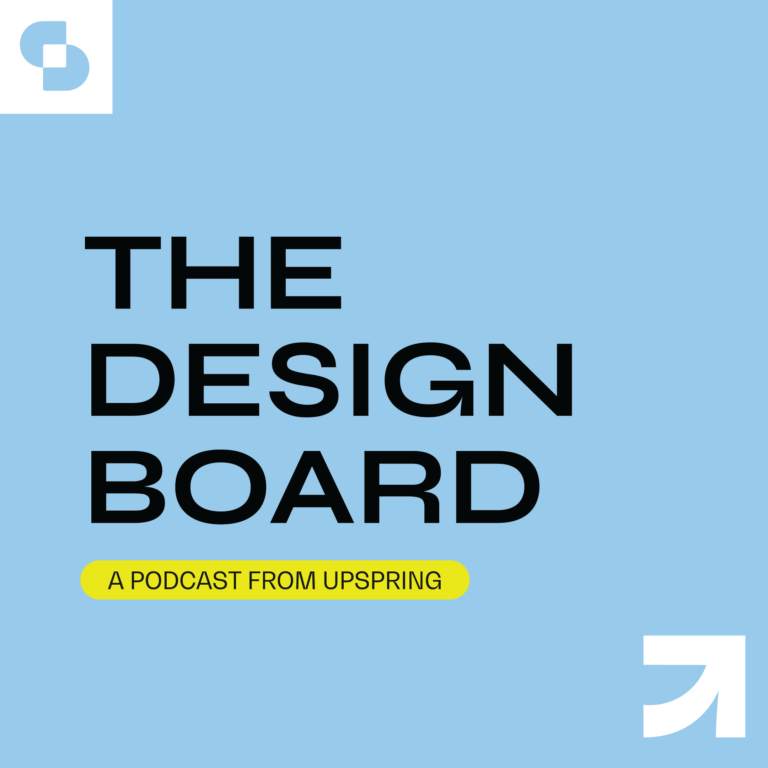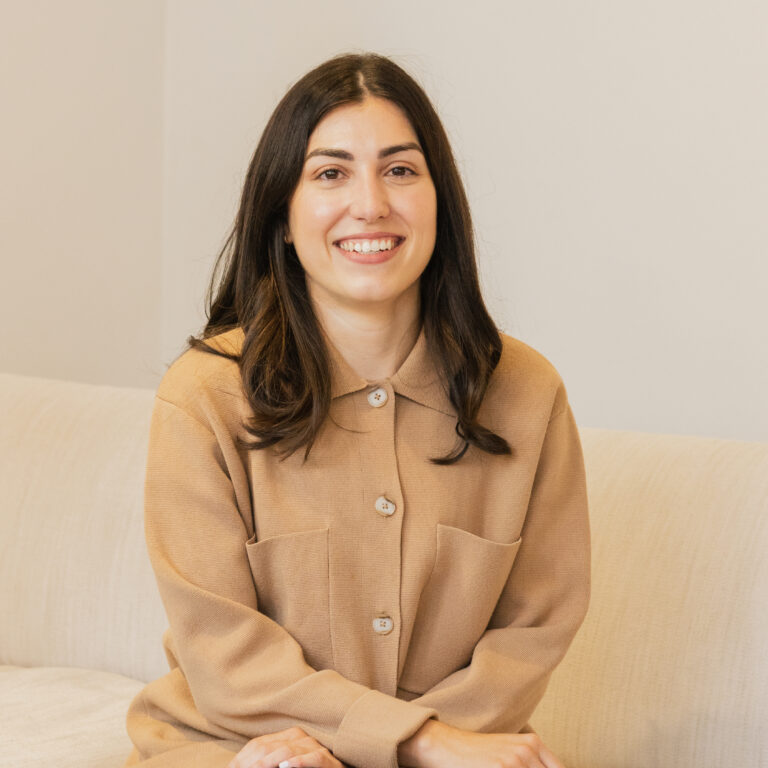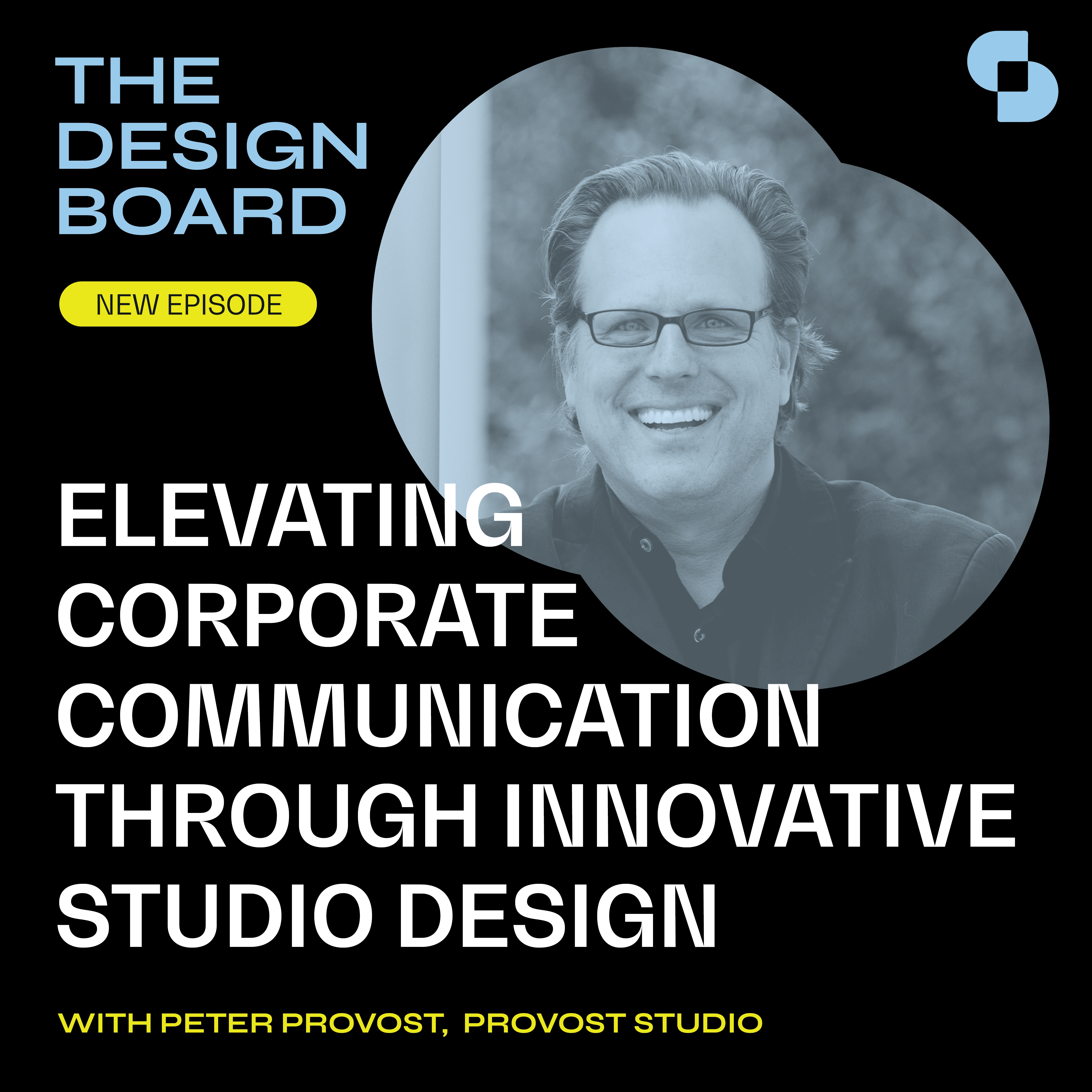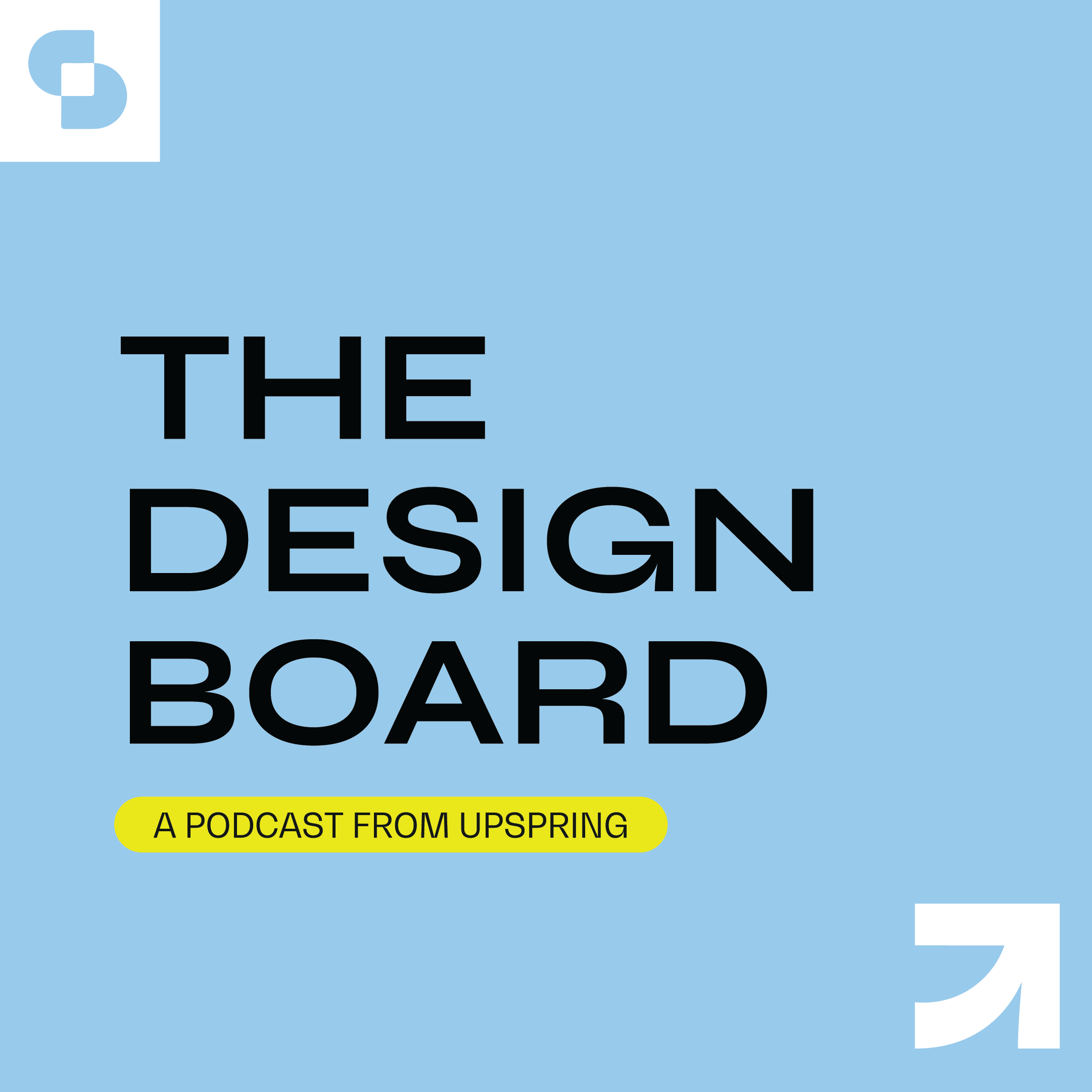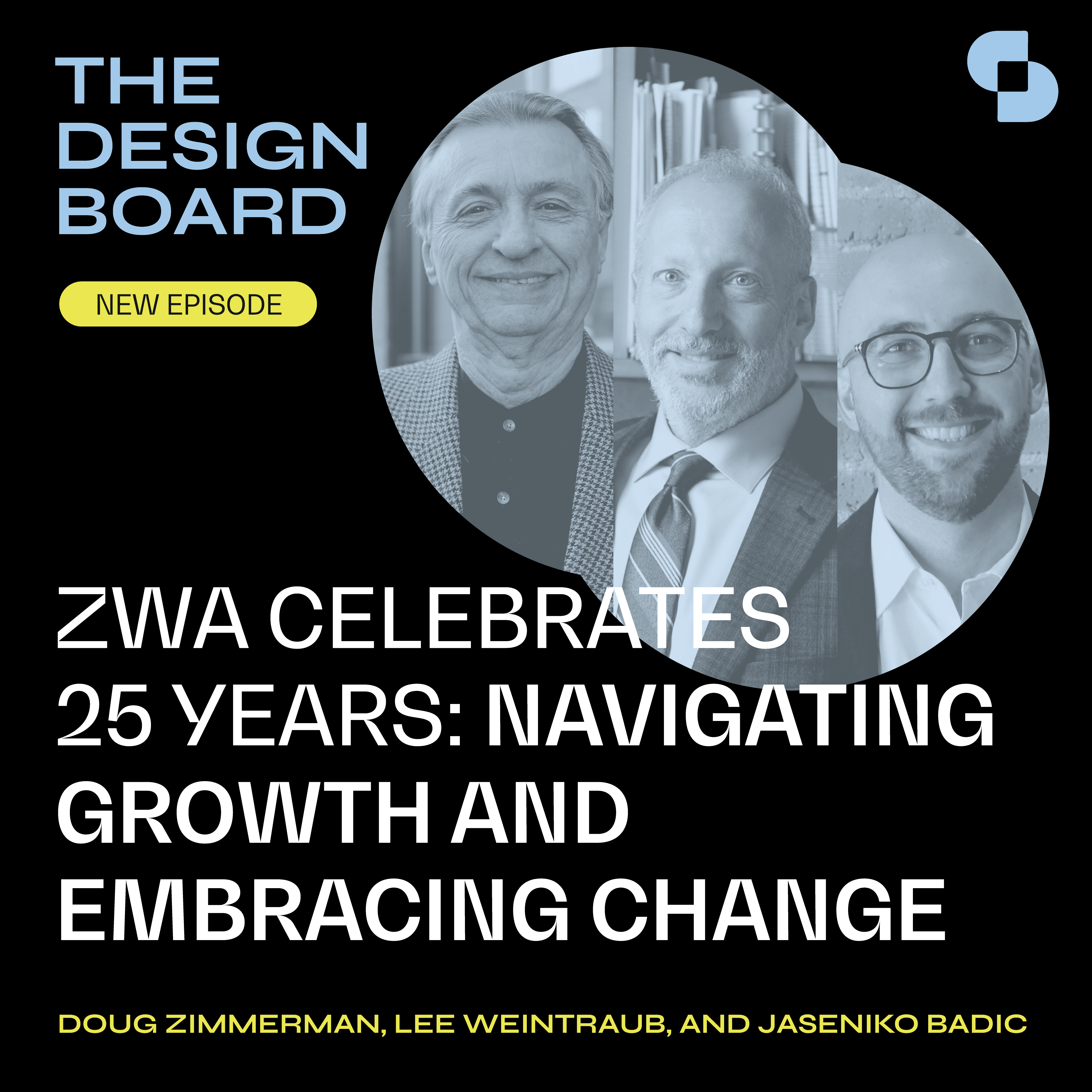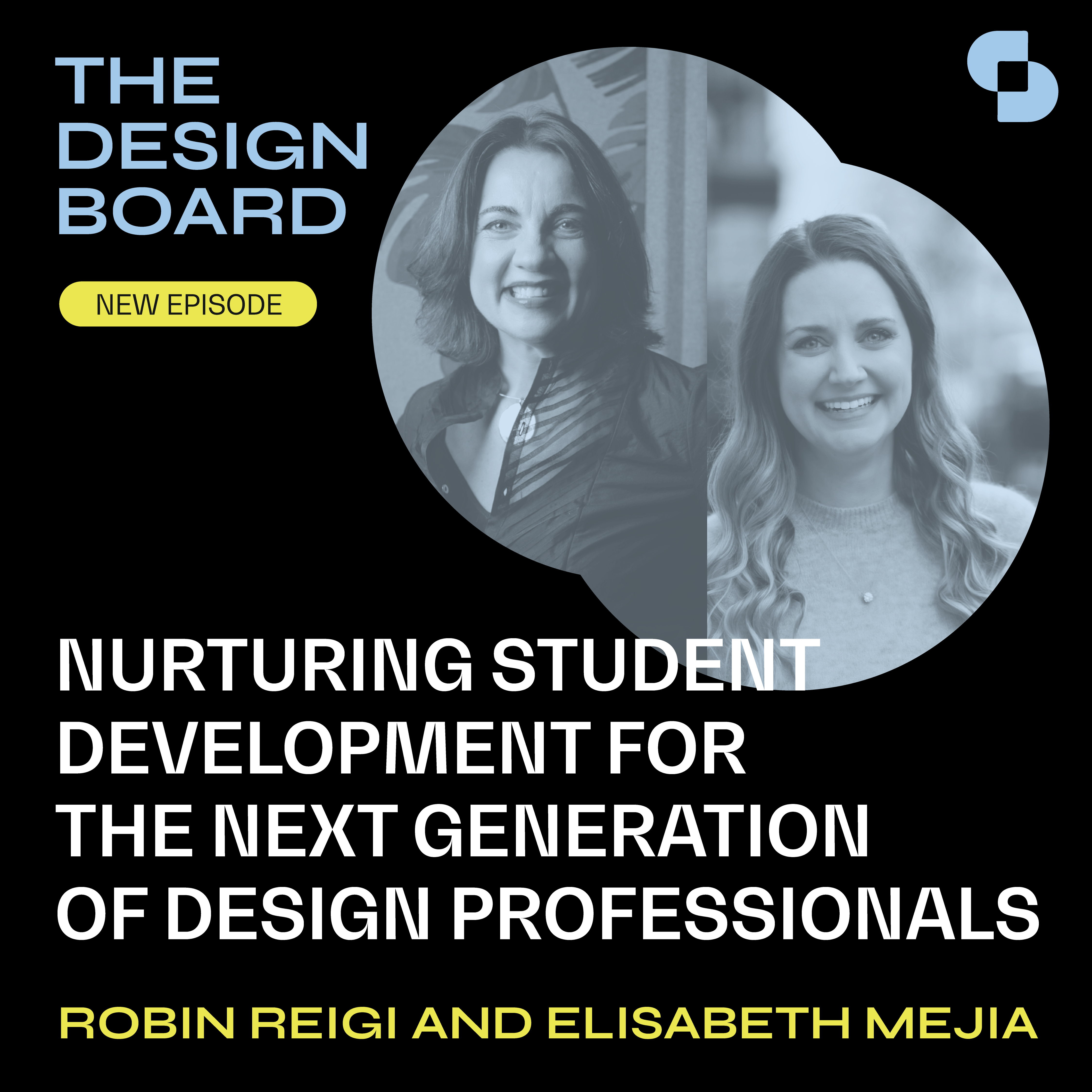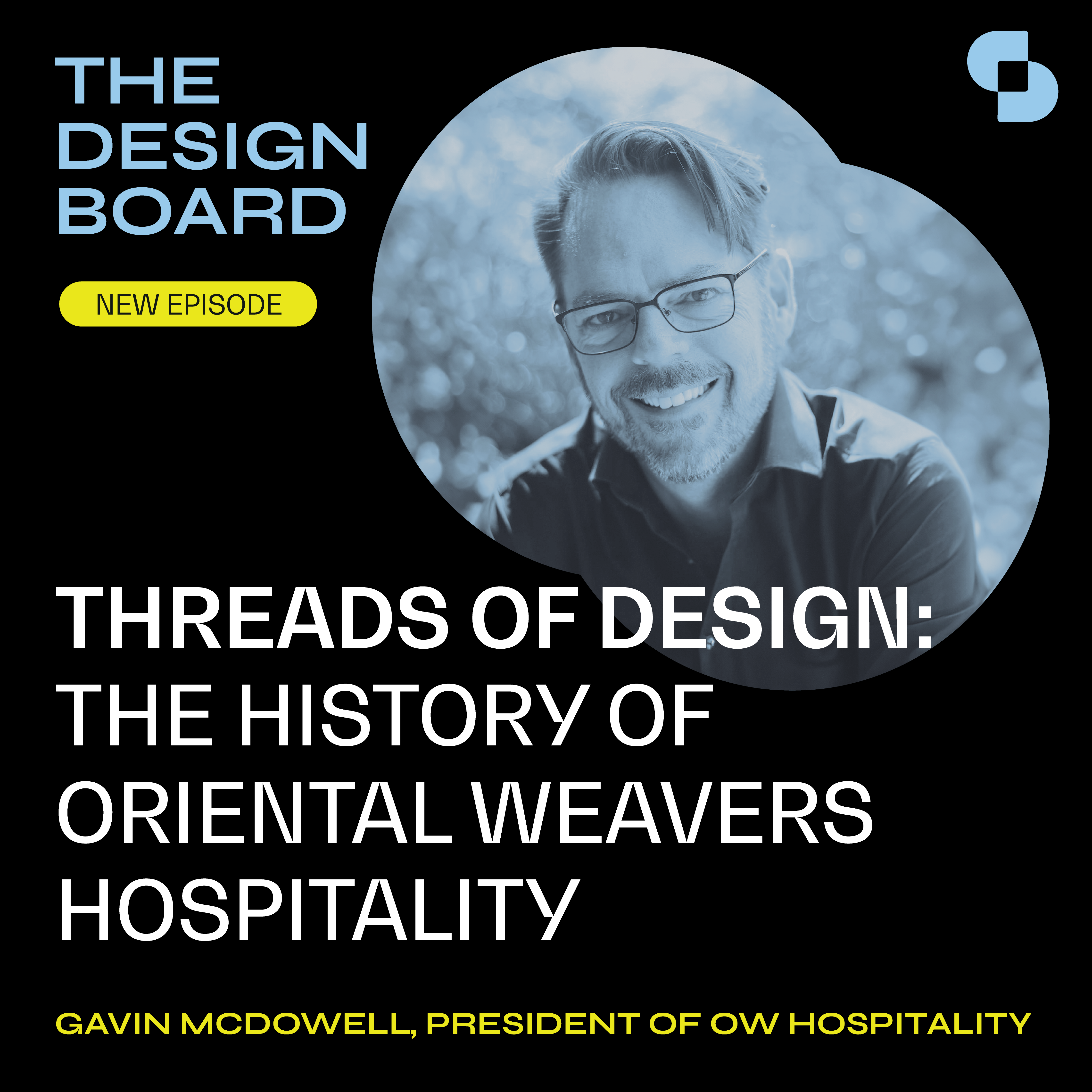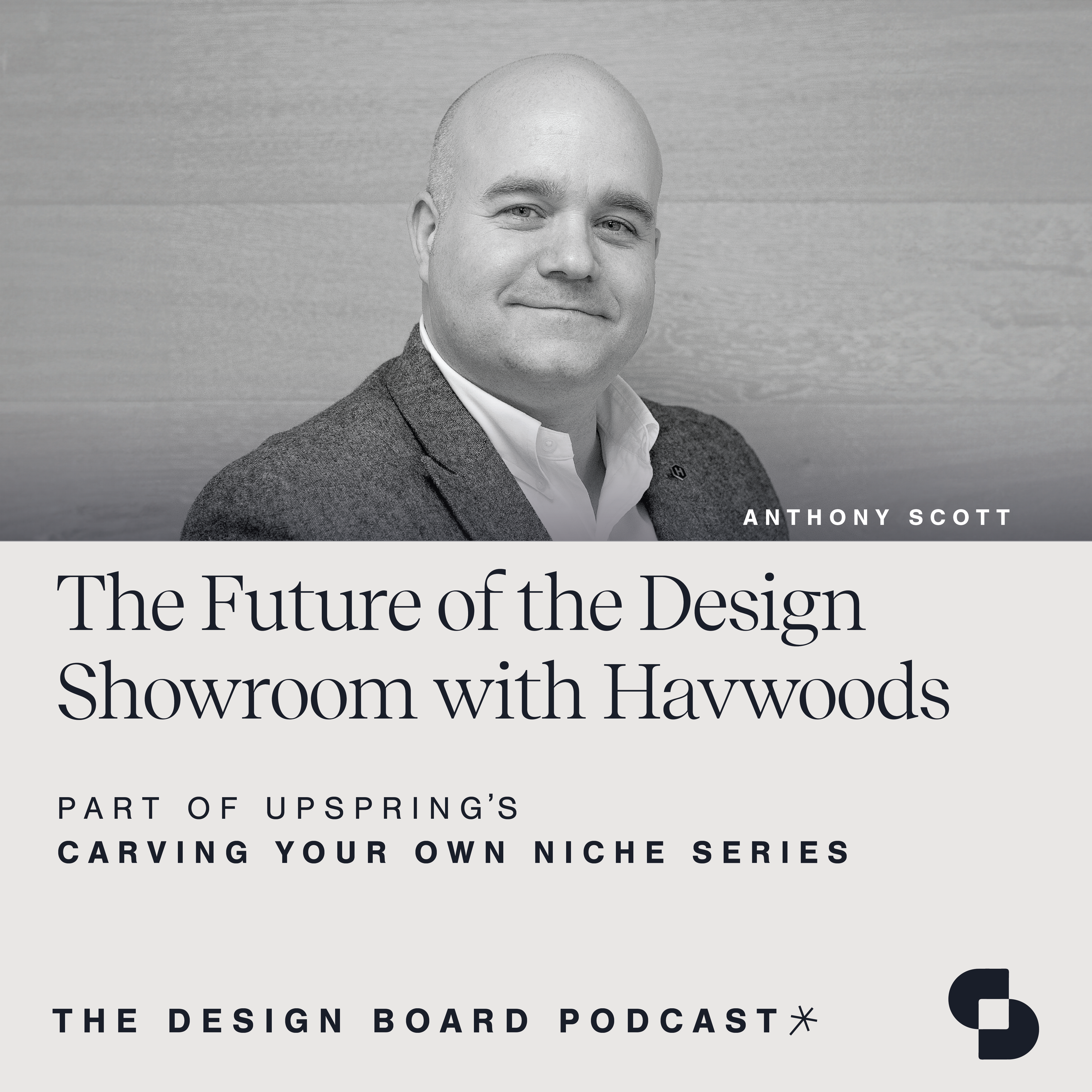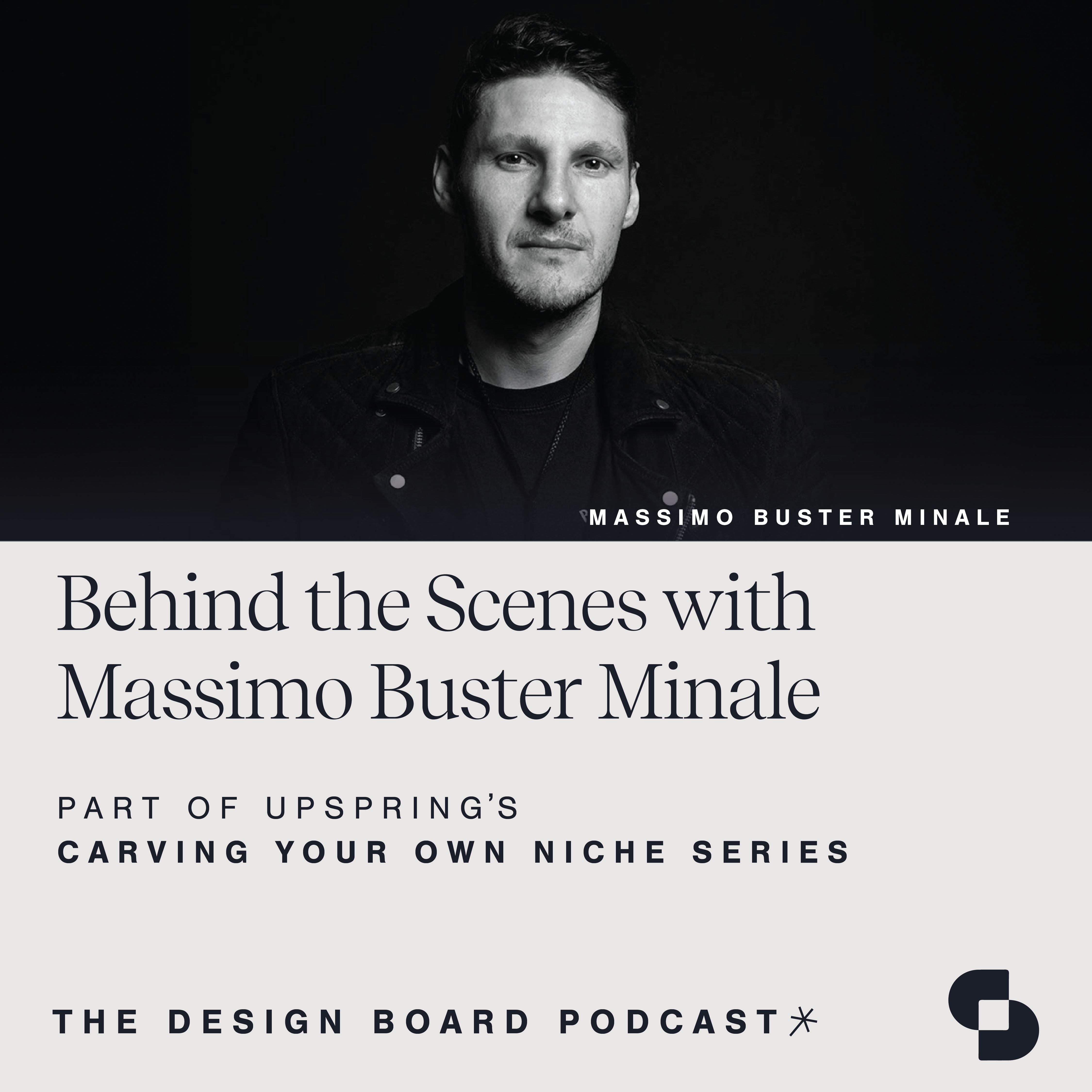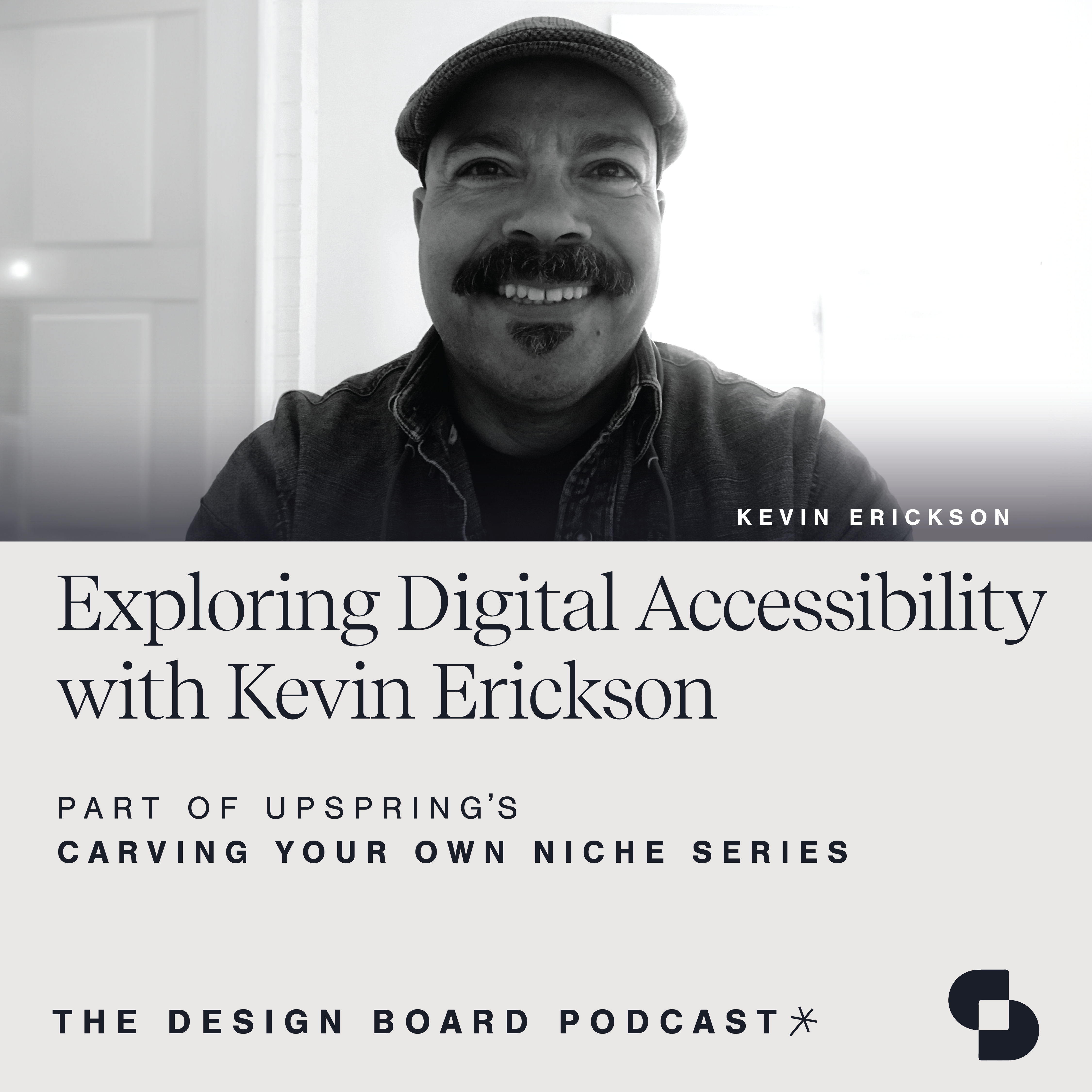In this episode of The Design Board, host Caroline Saba sits down with Founder and Principal Architect of Ervin Architecture, Rob Ervin, to discuss key considerations for designing large assembly structures that are centered around the optimal fan experience. In this discussion, Caroline and Rob will explore his ongoing work at the Maine Savings Amphitheater, the largest venue north of Boston.
The Design Board, by UpSpring, is a proud member of SANDOW Design Group’s SURROUND Podcast Network, home to the architecture and design industry’s premier shows.
Speaker 1: Welcome to the Design Board, a podcast created by the team at UpSpring that focuses on design, development and everything in between. We invite innovators in our industry and explore topics that support your growth in every way. The Design Board is a proud member of Surround, a podcast network from SANDOW Design Group featuring the architecture and design industry’s premier shows. Check it out at surroundpodcasts.com.
Caroline Saba: Welcome everyone to the Design Board, a podcast by UpSpring that focuses on design, development and everything in between. I’m your host, Caroline Saba, and today I’m joined by Rob Ervin. He is the founder and principal of Ervin Architecture, a visionary architecture and interior design practice with offices in Maine in Florida. Robert established Ervin Architecture in his hometown in 2012, adding an office in Tampa Bay in 2016 and an office in Portland, Maine in 2020. Motivated by a relentless drive to bring his clients’ dreams to life. Robert’s leadership style embraces a hands-on methodology that draws from a multidisciplinary skill set, maximizing value for his robust client portfolio. Recent examples of his work include the Maine Savings Amphitheater, Francis Lake House, The Trust Room, and Kanù Restaurant and Bar. Today Rob and I are going to be chatting about the fan experience and how to optimize that experience. When did you know that you wanted to start working on projects in the entertainment industry?
Rob Ervin: That’s a great question. I think it really was, over the course of my lifetime, inevitable that I would end up in this position designing live entertainment venues, facilities, et cetera. I’d always been intrigued by performance. As a kid I actually did a bunch of acting in theater. So I was intimately involved in the behind the scenes, the operations, the artist-facing experience and being an artist and understanding stage left, stage right, being able to project sound, being able to orate. Simultaneously I was drawing like a madman and building as well as a kid. And these three loves really just started to synergize. As a child, you don’t know where you’re headed, but you embrace your interests and they open doors for you. And so as I began to develop the more logical side of my mind, I really started to get into the science of sound, strangely enough.
I really was intrigued by these, what are called solfeggio frequencies that are nine frequencies that actually impact the human body on a psychological and physiological level. And so I’ve always known that music is more than just the pageantry. It actually has a scientific and measurable impact on us. Religion understood that. Organs are tuned to these frequencies and you might feel a bit elevated after religious or otherwise going to a particular worship service. That’s intentional. And I think that that’s just one example of how sophisticated these facilities are and why they’re so popular. And I got to say, when I started my company, we did everything under the sun. You start out and you take what you can get, you get the work you get, and you may want to do a music venue, but you’re doing camp renovations and you evolve into medical office and then you start doing surgical centers.
So we actually did surgical centers, which at face value are quite sophisticated. We also did high rise apartment buildings, which has its own degree of sophistication. But being someone who likes to challenge himself and challenge my company, large scale assembly occupancy, there is nothing more complicated. There is nothing more challenging. And I think that the sophistication, that high level sophistication and complication is what is ever stimulating and ever challenging. So to answer your question specifically, it was an iterative, generative process going from commercial architecture, business office, and commercial residential design and moving into assembly occupancy and starting small and going from restaurants to nightclubs to theaters and onto some of the biggest assembly occupancy structures in North America. So for me, it’s always been the challenge, but this project type synergizes with my own personal intrigue in sound and performance.
Caroline Saba: Yeah. I think that’s so interesting. I love what you were saying too about the power of sound, going back to what you were mentioning about the organs, and it’s supposed to make you feel a certain way. I think that’s so interesting so that was a helpful tidbit too. So I want to talk a little bit about that specifically with sound and experiences and what people are looking for when they are going out to an experience or a concert and what their expectations look like now, maybe before the pandemic or just as things have evolved.
Rob Ervin: That seems to be a hot question. I think we’re still in this retrospective mode. I think many industries are using the pandemic as a lens into not so much how it happened, but how did we respond to it, what’s the aftermath look like and how do we prepare for the next … I hate to say it, the next consequential event. And right out of the gate you can say people, there was a lot of pent-up demand. There was a lot of pent-up demand. People were itching to get out of their houses, they were missing interaction, they were missing things that had been eliminated from their daily life. The promise of live entertainment was a big part of that. As simple as going to a movie theater and is all the way up to, in terms of increasing scale, large scale sporting events and live entertainment events such as music.
I think that certainly the demand has never been higher. But I think that what it’s done is it’s reframed the fans’ value structure. They want things to be touchless. They don’t want to have to touch public surfaces. I think that that’s probably been ingrained in this generation forever. So touchless, hands-free interactions. That goes as simple as walking through the front gate and having your entire body and your belongings scanned by highly sophisticated technology. Not having to take your belongings out into a basket, interact with attendants. That’s certainly where the industry is headed.
Certainly cashless venues. The interaction is through technology and not direct exchange of money. That’s certainly a piece of what we’re doing. And also what I believe is people … And psychiatrists and psychologists and sociologists can unpack this, but people are more impatient than ever before. And I think that there are articles and certainly medical essays and things that are being produced that are unpacking this, but in another life, maybe I would help figure it out. But for me, it’s just acknowledging a condition. And this is part of what architects do. We acknowledge a condition, we acknowledge a tendency, and then we respond to it. So the natural course of thought here as it applies to a music venue would be, quite frankly, giving the fans the ability to order food from their seat. Have it be almost fully catered. Some of the luxury experiences in the venues we’ve designed we’ve implemented that kind of relationship. For more mass gathering seating sections where the logistics of doing that is challenging the trend is to increase the number of food and beverage offerings, have them at shorter distances from seats, and to create revenue models at the point of sale to keep the line short and keep people moving through the opportunity to get some food, to get a beverage, to access the bathroom and get back without missing too much of the performance.
This is a really interesting thing for me, is that I think there’s a valuation of time. I think people value their time now more than ever, despite the fact that they waste so much time scrolling online. When they’re out and about, they want to spend less time away from their seats, and that time period of tolerance has shrunk. So if you spent five minutes in line and you got a beer and you got back, you might look at that and say, that’s a hell of a valuation in a venue that’s 17,000 people. But where’s the threshold? Is it 10? Is it 15? Is it 20? Are they willing to wait 20 minutes? So we want to make sure that we understand that human relationship to time now more than ever, so that the review of the venue is positive, that the fan feels like they’ve maximized their experience, maximized their dollars. So that’s an integral part. That’s one of the primary drivers of design, believe it or not, is short lines in a music venue that respect the time valuation of fans.
Caroline Saba: Yeah. I love that. I went to opening day at Yankee Stadium last year, and my fiance went to go get a hot dog. He was gone for 15, 20 minutes, missed the first three home runs, and he was so upset. So I agree with you. I think that efficiency, like you’re saying, maximizing your time. You’re taking the time out of your day to go to this experience, and so you want to be able to enjoy it. So it’s interesting the way you explained that, what those different touch points could look like to really minimize that friction throughout that day.
Rob Ervin: Yeah. And one of the things that I haven’t seen … Now, I’ve been to a number of different venues. I see live stream throughout a sports facility, but I don’t necessarily see live stream throughout a music venue. So whereas at Yankee Stadium, you go to get a hot dog, you might actually see the home wrong on a screen. You can hear the roar of the crowd, feel like you’re at least somewhat part of it. You’re not jumping up and down and hugging your friends in your seats, but you’re in it, you’re in the milieu, you understand what’s going on. Music venues don’t really have that from what I’ve seen, and maybe that’s a trend that’s coming where you are in line, you can hear the music, but with the increasing amount of pageantry on stage, you’re still part of the action.
Caroline Saba: Yeah. I think it’s tough because I think especially concerts or music venues, it’s really hard to decide when you are going to get up and leave because not oftentimes you know the full set list. So you don’t want to miss anything too if you really are a die hard fan. So I think that’s a great point. Finding out what that looks like so that when people do need to go to the bathroom and wait in line or do want to go get a snack or a water, that they have the opportunity to still tune in some way. So let’s talk a little bit about current projects that you’re working on. Can you share some insight about the Maine Savings project and give us an overview of what you’ve been up to?
Rob Ervin: Yeah. We are in a very unique transition period and it’s a product of our evolution and the path that we’ve taken. We really do it all. The supplemental work is always commercial architecture and assembly occupancy. So when I say supplemental work, it’s restaurants and the like. We do really enjoy effect-driven architecture, creating a brand for a client, creating a vibe as the kids say, and really understanding the enjoyment level for us as a company even dabbling in smaller scale projects. Architecture’s a mental puzzle and every project, has its own intrigue and mystique and requires its own set of problem-solving approaches. As far as large-scale assembly occupancy goes, Maine Savings Amphitheater is certainly … We’re coming out of the wake of one of the most significant phases of that project. That project is a six-phase or so project. We even worked through the pandemic because construction was considered a critical enterprise. So we were fortunate in some of the site work that we were doing where we could literally step on the gas instead of picking up on the gas through a worldwide shutdown. So we were very fortunate about that. Fortunate to have those circumstances. I know that the lack of revenue on the client’s standpoint was extremely difficult, but we were able to capitalize on that and work during that time period.
So just as a summary on what Maine Savings is, Maine Savings is the largest assembly occupancy venue north of Boston. That includes indoor and outdoor. It caters to the Canadian Maritime, more the inland areas like Montreal. It has reached down into the Portland Maine sector and into the Boston area and out into the west of New Hampshire and Vermont. It’s really a regional entertainment hub. It’s got a really impressive cross-section of elements. It’s built on a crescent moon site between a river and a main street elevated thoroughfare. And so the location is exceptional. It’s an urban site, it’s within walking distance of downtown, close to other amenities up Main Street.
The site poses its own challenges. It is wedged between a river, the largest river in Maine and the main street, the main thoroughfare coming down through the city of Bangor, Maine. It’s got great proximity to the downtown. Within walking distance. But it does have its site restrictions and it’s pressed from the west by the street and from the east by the river. And so it’s a curving narrow site and it required a tremendous amount of engineering of space, finding space that could meet the needs of the client. And the client really wanted to, like what we talked about earlier in the conversation, really wanted to give the fans an exceptional experience with improved bathrooms, better concessions offerings, expansive corporate clubs and perching suites that overlook the stage. A lot of sophistication in the program and certainly a high capacity venue on a small site. So we had to really engineer space.
Now how do we do that? Well, two of the fundamental things that we did was we used retaining walls to hold back Main Street. So we were able to commandeer the hillside that sloped towards the river, and we were able to tuck program into that what was a hillside. So that was a big win. We also, Ervin Architecture had to get creative with cantilevered spaces. So we essentially double dipped and we were able to provide one program over another program. So say for example, you might have a concourse that needs to allow a high volume of people in and out as well as you have concessions offerings. Well, you might look at that and say, well, you can’t build out into that area because that’s an essential region and that’s a restriction on the venue.
Well, the solution that EA came up with or Ervin Architecture came up with was cantilevered structure. So we have what’s called the dynamic load in two of our five buildings on site, which allows cantilevered programmatic space such as suites, circulation, clubs that hovers over circulation and seats at lower levels. So it’s a highly sophisticated, unique venue design, but it required an immense amount of creativity, and we were able to. Fortunately every time we seemed to find ourselves in a cul-de-sac going around in circles, we found a way out and we were able to get creative and build a road out of our mental barrier to additional opportunity and improvement on the design as it was. So it’s quite a process.
Caroline Saba: Yeah. That’s so interesting. You started to touch on my next question too, overall about the fan experience. A lot of what we’ve been mentioning. And for this project in particular, how did you make sure that no matter which ticket is purchased or where that person is sitting, how do we ensure that they get the most optimal experience?
Rob Ervin: Yeah. I love the question, and I’ll answer it in a self-deprecating way.
Caroline Saba: Oh boy.
Rob Ervin: We’d never done anything at this scale before. We’d never been tasked to put so many fans in front of a stage with so many competing variables. And what became a internal design polemic or argument advocating for the fan was just not the industry standard. We didn’t know that. So this is the example. Music venues throughout North America are being more and more designed towards a screen experience. So you go to the venue, I’m sure you’ve been to several, and you find yourself really watching a giant screen. You might be able to see the stage or see portions of the stage, but the primary viewing experience are the closeups of artists playing instruments. And in defense of that model, you’re able to see more of what’s going on on stage in hi-def. Unfortunately, a lot of times the view of the stage is occluded or interrupted. And I’m not talking about obstructed views where you’ve got a column right in front of your face and they say, “Sorry. Here’s 20% off your ticket.”
What I’m talking about is you may not see in clear focus the stage and the artists on the stage. You may see a portion therein. And the reason for that is that standard is the site line is measured four feet above the rear of the stage. So there’s usually a screen there, giant screen, capturing all sorts of different things that are going on stage. The standard is four feet off that back location. So if you’ve got that and you’re up at an upper level, your angle of declination coming down the venue and to the stage is going to be higher and may be higher and is oftentimes higher than the artists themselves. So you may find yourself, depending on where the artist is standing, not being able to see the artist at all, or maybe not being able to see one or two of the band members.
So we didn’t want that when we designed Maine Savings Amphitheater. So I came at it just like, well, I’m a fan and this is what I want and I want to be able to see the screen. Sure. But they’re secondary and tertiary in my value structure. So we started, when we modeled this parametrically and we looked at every single seat, we set up a parametric 3-D model, and we put our camera on every single seat. We actually put people in the seats and took a look at the stage. And would we be able to see? And the standard was mid-leg of the lead singer. Can we see? And because they’re the furthest forward, they’re the most difficult one to see. They produced the steepest angles from the seat. So that really drove the contour of the venue. It drove the elevations of the venue, it drove the pitches of the seating sections. And you probably have been to shows where you see what is called a thrust. That is where … I remember when I was at the Garden and I saw U2 on their elevation tour. They had this walkway that went out into the crowd, into the GA pit. And I remember Bono going out there and mingling with fans and people were having out-of-body experiences, and they were just hysterical. The whole thing.
And I looked at that, I said, wow, that is so incredible. He’s out mingling with people and he’s on an elevated platform. Well, that’s become the industry standard. That was 25 years ago, and that’s become the industry standard. Every single artist wants to get out. And I think it’s really driven by social media. It’s driven by tag, tag, re-tag attitude, drive the brand. I’m an artist of the fan. It’s very easy to do. You build a walkway, you get out there and you slap a few hands and take some selfies with people, and it really bolsters the brand. And for Live Nation and for others and for the artists that are packaged within the industry, that is definitely a focus.
So I remember we had all our sight lines sorted, and then the next curveball was, well, some of these artists have thrusts that are 45 feet off the stage. So we had to tip all of our sight lines to an extreme condition, which forced the venue to go higher and steeper. So Maine Savings really is focused around the artist and where the artist is at all times. The screens are supplemental. Now, had I been an insider, had I been in the industry and been programmed by the industry to design in a certain way, I probably wouldn’t have held myself to that standard. And so coming at it with a new set of eyes, a new brain, a new outlook on the value of the fan and what they want to see, Maine Savings really benefited from that. And it’s become a standard for fan sight lines and fan experience. So if you want to talk about one of the crowning achievements of that particular venue, it’s my own ignorance coming into it and holding the experience to a very, very, very high standard. And we’ve seen a tremendous response from the fans. The fans by and large, really enjoy being able to see the performer regardless of where they are.
Caroline Saba: Yeah. I think that’s such an interesting component because I always found that fascinating. And maybe this is more so with Broadway plays, but depending on where you’re sitting, the experience is incredibly different. I think maybe especially even with the Rockettes because of the way they format those dances, and if you’re on the left, you’re only really seeing a part of the show. So I think that’s such an interesting perspective that you’re really looking at it holistically from each person and where they’re sitting and how they’re taking in that entertainment.
Rob Ervin: If I could just add one piece to that, one of the things that’s near and dear to my heart is equity. I really want to make sure that people have similar experiences. And I think just very quickly, I wanted to take the seemingly overlooked areas, the 200 and the 300, the middle of the venue, the people that might be able to afford a slightly better experience, but they can’t quite get down in front of the stage. Those areas based on what they’re paying in the traditional experience aren’t very desirable areas. And we really wanted to make sure that every single fan was valued equally. And that’s what we’re seeing the people recognize. Many of these people go to multiple shows, they’ve been to multiple venues, and the reviews and the ratings show that they do acknowledge that, and they do appreciate that.
Caroline Saba: Yeah. I think that’s great. And then I loved what you were saying too about the U2 example and now how the bands really do want to connect with their audience. And I feel like that has even become more important post pandemic too, because people want that connection. They want to feel a part of what’s going on, and they were a part of that experience that night, that specific day. So I think that’s super interesting too. You mentioned something in the beginning as well about the bathrooms for this project. Can you walk us through that a little bit more as well? The fixture to fan ratio, I think you mentioned.
Rob Ervin: I think that the client has certainly had to face this head on, and I think the brunt of it was felt before I arrived. The majority of the experiences were, quite frankly, porta Johns when they were first starting out their enterprise, starting to get bands, starting to show Bangor that this could be a thing. And then the economic impact is starting to be felt and some of the noise complaints are resolved, and this collective evolution in the community, the city starts to benefit. And to the credit of the client, I was a fan for years. I believe the venue’s now over 10 years old, and I have been a part of it for better part of 50% of that I believe. Somewhere in that area. But in any event, as a fan, I knew that every year I came back, this client was reinvesting in the experience, and he’s done that every year that I think that the venue’s been in existence.
So there’s been a real commitment to the fan. The big item, I think on everybody’s mind, the standard operating metric is you’ve got to have running water, you’ve got to have bathrooms. So we introduced bathrooms and then suddenly there aren’t enough bathrooms, and the lines are too long. This was one of the smaller phases that occurred. Loved the bathrooms, but had to increase the number. And so that’s when we started to develop … To the client’s credit, he’s out and he’s touring these venues and he’s meeting with the operators and he’s giving me to his credit conditions that he would like to see. And then it’s up to my team to go, well, how the heck are we going to do that with this kind of site? It’s already packed full. There’s a lot of restriction already, but let’s find a way.
And so one of the guiding principles was this ratio of one bathroom fixture for every 60 fans. And that holds true for men and women. And that was something that was one of the most significantly challenging. Second only to maybe the sight lines that Ervin Architecture had to embark on. We had massive requirements for ingress and egress, which chewed up a lot of real estate, meaning wide thorough fares so that people could enter and exit safely. And then the requirements of course for seating itself. So what was left over, we had to put clubs, suites, concessions, and the all-important bathrooms in. And so that one to 60 ratio comes from large-scale, cutting edge national football league design approach. That was something that the client handed to us, we developed, and we were able to put that standard, that requirement into our venue to even further separate it.
And it all gets back to the length of the line. The lines were significantly reduced because the accessibility was increased and it’s what was a complaint of the venue is now a strength and is a non-point. It’s not mentioned. So it’s operating at a very high level if public is not complaining or even complimenting. It’s become a standardized element of the venue. And so that one to 60 ratio is state-of-the-art, it’s cutting edge. We adopted it when it was cutting edge, and it’s becoming now the expectation of the fan that they’re going to be able to walk in and not have a line to the bathroom or have a very minimal line to the bathroom. So that means that you’re chewing up a lot of real estate and you’ve got to get creative on toilets and urinals. Where do they go? And there are requirements for the number of sinks per toilet. So it’s a lot of real estate. And the way that we did that is we tucked them into the undersides of much of the retaining wall structure that holds up the venue. So again, engineering for space. Engineering for amenities on a site that seemingly didn’t have any more square footage to give.
Caroline Saba: Yeah. That’s super interesting. That’s really great. You just hit on amenities too. So aside from the bathrooms … And maybe this is more for the performers as well. What about considerations into designing for them? Are there any specific amenities or facilities to call out, whether that’s for this project or any other modern day venue that’s important to have for the performers?
Rob Ervin: So that’s an excellent question and I appreciate it. The artist experience is becoming in an increasing manner, the focus of venue design. It’s shifting or perhaps equal parts fan and artists. So just like the fan experience, the sight lines, the proximity to food and beverage, the bathrooms, the acoustics and ease of access and these kinds of things that we’ve touched on, the backstage amenities have to be top-notch. And when I say backstage, I mean for the artists. We’re talking lounges, spas, weight rooms, high-end food offerings, places where they can get away, dressing rooms that are really apartments. The backstage amenities are becoming really a driving or the driving force for new venue design. Client came up with an amazing idea. We’re putting in a single whole golf course behind the stage for artists. So we’re doing that this year. We’re putting that in. There’ll be a driving range of sorts with a putting green. There’ll be a net so that the balls don’t end up in the stadium.
Caroline Saba: That’s important.
Rob Ervin: But that’s the kind of thing. They want to be able to shoot hoops. They want to be able to be isolated in a Zen environment that’s incongruous to maybe the artifice of the venue itself. So all of these things factor in. When you’re on the road and you’re an artist, you’re going from one town to the next and you’re trying to recalibrate your brain and you’re trying to do it all over again with the same enthusiasm and the same output. And so the venues that offer recreation and offer luxury for the artists are the ones that get booked. It used to be that those that control the venue, control the destiny of the artist. Live Nation came along and really flipped the script, and the artist really calls the shots. And so if you don’t have a great, what they call backstage program, you’re not going to get top caliber acts.
So that’s a process that we’re involved with where we’re always adding as we can, adding to the lineup of amenities for the Luke Combs and with Luke Bryan, and you name it. Jelly Roll, a lot of country acts come through there. Their standards are a little more reasonable, a little more commonplace, but you start to get into some of the mega old rock and roll acts, they can be a little temperamental and they want their blueberry scone and they want their massage before the show. So that’s certainly a big focus and it’s really, I would say, one of the next pending phases of the rollout in the Maine Savings Amphitheater.
Caroline Saba: Okay. Great. That’s so interesting because I think we spent the whole first part of this conversation talking about the fans, but from what it sounds like it’s just as important to think about the artist and who else will be using that other half of the space. So that’s super interesting too. We touched on a lot of different topics. There’s so much I feel like to dive in here, but I want to leave it off with just a larger more thought-provoking question too, of really what you feel like the future of architecture and design is for live entertainment and what we could expect. I know you’ve already hinted a lot about it, about creating more efficiencies, more technology, supporting the performers, giving the fans the best experience, but anything else you think you could call out of what things people will be looking for?
Rob Ervin: I get asked that question a fair amount, and I am not in the inner circle of the industry. I’m on the outside looking in and I get information in real time that’s applicable to the present moment. So my clients are in high level meetings and they will let me know what is what with I would say, some foresight, but not the foresight that I think the question is looking for. From what I see without, like I said, being in the know is I see live music entertainment heading towards a similar model as, say, for example, pay-per-view. I think that the devices, the technology that we have now, these virtual devices that we can now use, augment reality, I think that the live entertainment industry is looking at it much like looking at concerts, much like the National Football League looks at the Super Bowl, looks at Sunday football, UFC looks at fights in the octagon. I would think that they are looking to monetize concert experiences.
I think that for whatever reason, there’s been a translation from live experience to living room experience that has fallen short. And I think some of the new tech will certainly supplement that. I think that it will increase markets, it’ll improve revenue models. I think that the irony is in some cases it may hurt ticket sales, but it may actually increase revenue for the promoter with advertising partnerships. I always believe that the live performance will be essential, much like the live performance in sports will always be essential. But I think the monetization of the fan experience and the expansion of the fan experience is definitely on the minds of people who control the industry. And I think it might prove the individual experience in the venue becomes even more critical because the live performer wants a sold out show, but has a “threat” of people staying at home.
And I think that it’s just playing professional soccer. I would think the players want as many fans in the venue as possible, just like performing music, I think it elevates their performance. I think it’s really a critical part of the relationship between performance and the fan. And so it might be even more critical to create venues that are sensational. That despite the supplementation of a market that is the couch market, I’ll call it, you’re now trying to entice people off their couch and get them to the venue. And so I think it’s going to be an interesting dynamic. It could very well raise the standard of the live experience. And coming all the way back around to the pandemic, I think that if this was ever to happen again, the industry would have to embrace something like this. They touched a little bit on it, but I think they were caught unaware and had to scramble.
But I think this idea of virtual concert attendance is coming. That for me would be the single greatest trend that I see. We’ve been watching performances the same way for thousands of years. The Greek sat in amphitheaters, like the venues that we’re designing. So there’s a certain relationship between live performance. And I think it gets back to these solfeggio frequencies, elevating your experience, making a memory, and I think certainly the live experience is always going to come with a certain premium and a certain intrigue. So I think that moving forward, there’ll probably be some sort of a hybrid model.
Caroline Saba: I think that’s so interesting. I guess at this point, only time will tell too, depending on how people’s needs continue to change and evolve.
Rob Ervin: Absolutely. Tech is the curveball, right? Tech always pushes industries in ways that maybe are unanticipated, and then there’s an adaption period. I certainly think that AI is a good example in what it’s doing to architecture and design. So we’re adapting to that. We’re embracing it. We’re using it as a strength rather than a marginalization of some of our skillsets. I think that virtual technology is certainly going to start to encroach on live experiences and probing the depths of what that means, I think now gives our clients a little more advantage in the future.
Caroline Saba: Yeah. It’s so interesting. Well, this has been such a great conversation. I’d love discussing this with you. It’s timely for me too. I was just at Madison Square Garden on Friday at a sold out concert. So it’s interesting to look at it from the design perspective as someone who genuinely likes to go to these experiences. So thank you again for the time.
Rob Ervin: Thank you Caroline. Wonderful discussion and happy to do it. And I hope this was helpful To those of you out there that are listening and learning about live entertainment venue design.
Speaker 1: Thank you so much for listening in with us today. We hope you leave inspired by the ideas in today’s episode. For more follow UpSpring on LinkedIn and Instagram. And don’t forget to check out the amazing lineup of shows brought to you by the Surround Podcast Network at surroundpodcasts.com.

